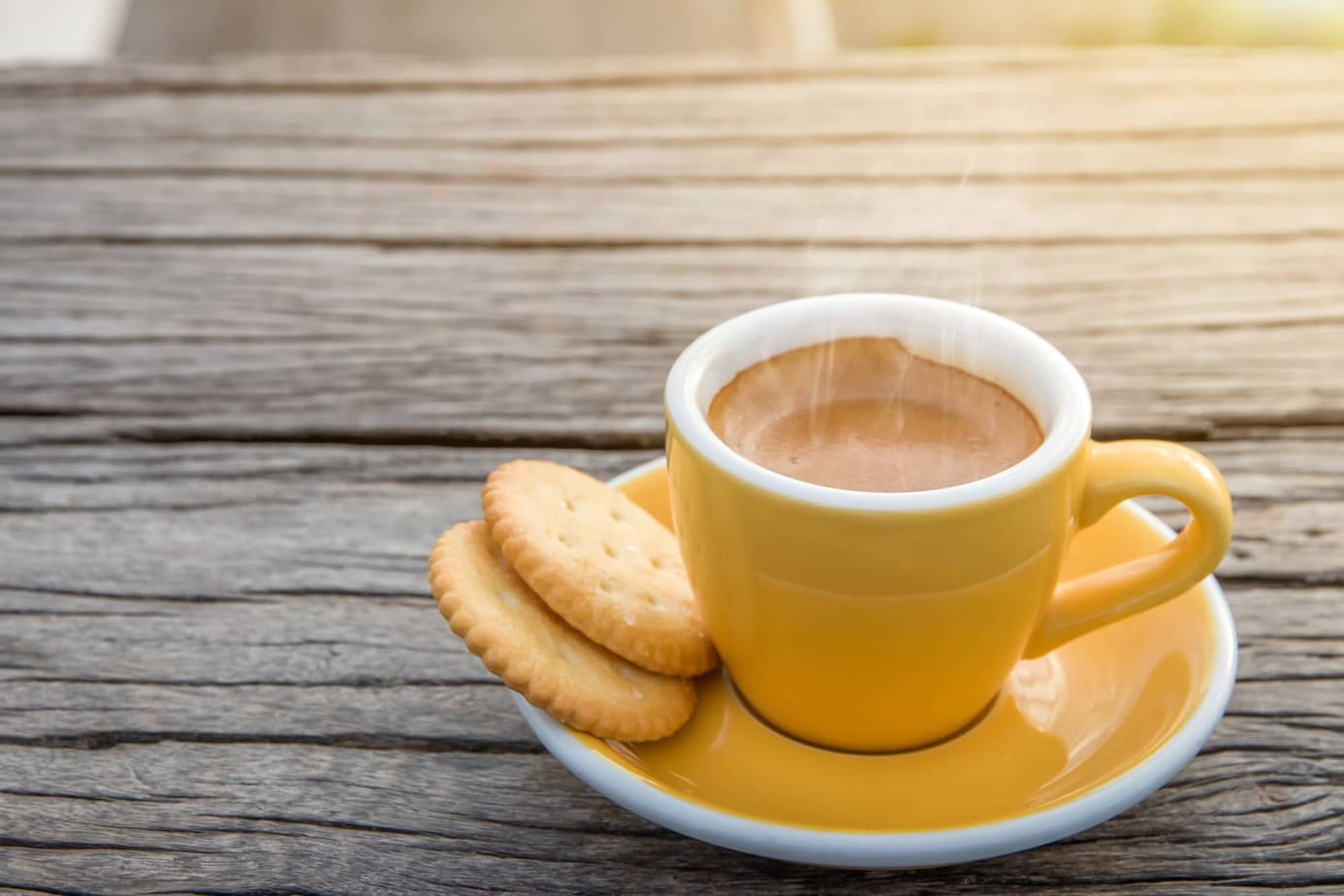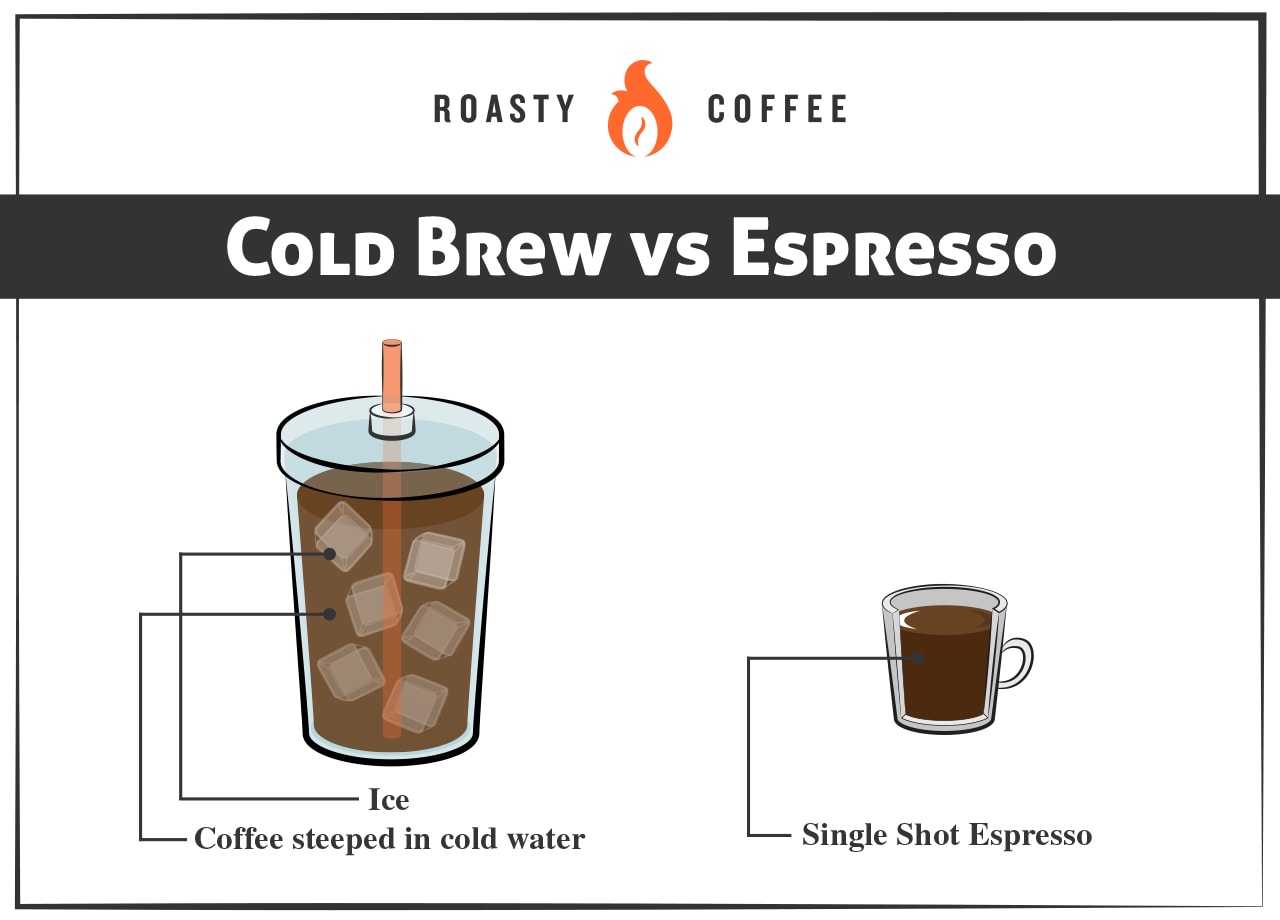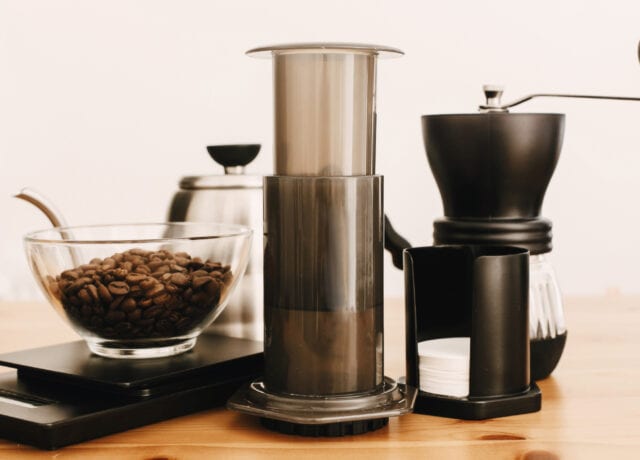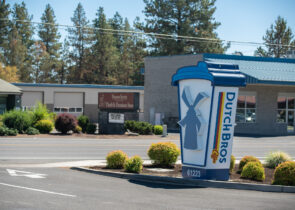If you’re a coffee fan, have spent any time in a high-end coffee shop, or have even walked into a Starbucks in the past five years, you’ve probably noticed the newest delicious coffee craze that has seemingly taken over America: cold brew coffee.
This incredibly strong, bold, and robust cold drink packs a punch and puts a new spin on the concept of iced coffee. But how does it compare to the age-old classic espresso? Which one has more caffeine? And which one tastes better?
Unsurprisingly, the answer depends on a variety of factors. While personal preference of the coffee enthusiast is undoubtedly the most significant factor, it also depends on the type of espresso used, the type of beans, how each drink is made, and so forth.
In this article, we’ll make a detailed comparison and explore the critical differences between cold brew and espresso. We’ll also answer all of the questions you need to know so you can be on your way to becoming a certified coffee pro.
Espresso: The Basics

Espresso is that sleek, sexy, dark coffee drink that you’ve seen sipped in fancy coffee shops worldwide. It’s that coffee served in those teeny tiny cups, but it’s also the base for all your favorite coffee drinks like lattes, frappuccinos, cappuccinos, or any other fancy coffee drink.
So what exactly is espresso? It’s actually the same thing as coffee except brewed differently. That’s right: you use the same type of coffee bean for your regular cup of joe as you do for your espresso.
The critical difference is how the beans are ground and how they are brewed. The beans are ground very finely and compressed while hot water is forced through the grounds, which creates a shot of espresso. As a result, espresso is a more concentrated cup of drinkable coffee. It’s stronger, bolder, and usually has a more acidic coffee taste.
Most people don’t know that since espresso is served in smaller servings than coffee, it surprisingly contains less caffeine than a standard cup of coffee.
The reason why espresso is so popular is that it’s the base of all your favorite drinks. Whether you’re getting an oat milk latte, an extra frothy cappuccino, or a macchiato, they all have an espresso base. Actually, all of those drinks contain the same amount of espresso (usually just one strong shot), but the amount of milk, foam, froth, and flavoring varies depending on the drink you’ve ordered.
Espresso has been around for years. Created in Italy, espresso is enjoyed frequently throughout the day as a pick-me-up or as a delicate, rich drink to slowly sip after meals.
Cold Brew: The Basics

Cold-brew is a more robust (and more expensive) version of iced coffee. Popularized by Starbucks in 2015, cold brew has steadily been taking over the hearts of coffee drinkers across America. Though it has its roots years before then from coffee companies like Stumptown, the cold brew craze happened because of Starbucks’ marketing.
Though it’s more expensive (usually by two or three dollars), this drink far surpasses iced coffee in terms of flavor, smoothness, and caffeine.
Like all coffee drinks, the main difference between cold brew and iced coffee is how they’re brewed. Iced coffee is made by running hot water over coffee grounds and then naturally letting that coffee cool off by setting it in a fridge for a certain number of hours.
Once you get your coffee icy, you put an ice cube or six in the cooled-down coffee, and voila: a perfect cup of iced coffee. However, this basic process doesn’t result in the best coffee cup because the coffee flavor is often somewhat diluted, and the coffee itself isn’t very fresh.
Cold-brew, on the other hand, is engineered quite differently. Cold brew is made by soaking coarse ground coffee beans in room-temperature water for a whopping six to twelve hours. Steeping the ground beans creates a coffee concentrate you can later mix with cold water for a potent coffee drink.
And because the grounds are steeped over such long periods, cold brew tends to be a much less acidic-tasting coffee.
In fact, according to coffee connoisseurs, one cup of cold-brewed coffee is 67% less acidic than traditionally brewed coffee. So, if you are sensitive to acid, cold brew is an excellent alternative to iced coffee or iced espresso drinks.
Check out some of the best cold brew coffee makers here!

Cold Brew vs. Espresso: Taste
There are a lot of factors that can affect the taste of a cup of coffee. The amount of acidity undoubtedly plays the most prominent role as a more acidic cup tends to taste much more bitter. If you prefer a smoother, less acidic cup of coffee, then you might find a cold brew tastes much better than an espresso drink.
Of course, espresso is much more versatile than cold brew. Most people take their espresso in a latte (only serious coffee drinkers drink a straight shot). You can easily dilute the bitterness by either adding more milk or water. Doing this cuts the strong taste of espresso without compromising how much caffeine is present in your espresso drink.
Even doing that, cold-brewed coffee has a much less bitter taste and an overall smoother coffee tasting experience. And, if we’re simply comparing one drink of cold brew to one shot of espresso, the powerful taste of cold brew far exceeds that of a shot of espresso.
Cold Brew vs. Espresso: Caffeine
No matter how you slice it, cold brew has more caffeine than espresso. The cold brewing process requires a lot of coffee beans, usually double or even triple that needed to make a standard brew.
Most of the time, you’ll be making a cold-brew coffee extract. This cold-brew extract can be diluted using water, milk, or milk alternatives. This way, you can cut your cold-brew coffee, and it will still have around the same caffeine content as an espresso.
On the other hand, an espresso shot is just that; one serving of ground coffee beans. Not only that, but because espresso is typically served in a smaller cup, it usually contains less caffeine than a standard cup of regular coffee.
But don’t count espresso out just yet. Because an espresso shot is such a small amount of liquid, you can fit multiple shots into one espresso-based drink. Most experienced coffee drinkers often order coffee drinks with two, three, or even four espresso shots in one drink.
Not only does this increase the amount of caffeine, but it also helps to even out the flavors between milk and espresso so that you can taste the coffee a bit more.
Again, if we’re comparing a standard cup of cold brew to one single shot of espresso, cold brew is the clear winner in terms of caffeine. However, with espresso, you have the flexibility to add more caffeine and tailor your drink to your specific preferences, whereas with cold brew, you only have one cup.
Cold Brew vs. Espresso: Time
Espresso is the clear winner in the brewing time category. An espresso machine can run a shot of espresso from fresh coffee beans in about 90 seconds, whereas the extraction time for a quality batch of cold brew can be anywhere from six to twelve hours.
With this difference in brewing time, espresso is a much more convenient option. Whether you’re brewing coffee at home and you’re always on the go, or if you’re the manager of a coffee shop, espresso is the clear winner in terms of time and convenience.
Because good-tasting cold brew coffee takes so long to make, coffee shop owners must be accurate in the amount of cold brew they make for the day. Once you’re out, you’re out, and you can’t run in the back for more beans or brew extra icy coffee as you can with espresso drinks. This can be quite a headache in terms of keeping up with impatient or unempathetic avid coffee drinkers.
Final Thoughts
It seems like every day there’s some new fancy drink at Starbucks or a coffee drink that’s all the rage in a coffee-obsessed country. While espresso drinks have been a staple in the intense coffee-drinking community for decades, cold brew has made quite the wave, and more and more coffee drinkers are turning to cold brew as their preferred iced drink.
Without a doubt, cold brew has some serious perks. It’s robust, smooth, less acidic, and much more potent than your standard latte. However, there are still aspects that it can’t beat when it comes to the classic espresso drink. In time and flexibility, espresso wins hands down.
All in all, if you’re into a smoother cup of black coffee, cold brew can be a new adventure in coffee for you. If you enjoy that bitter coffee taste, you might want to stick to espresso. It all comes down to personal preference. Regardless, these are two fantastic coffee styles that will be enjoyed for years to come.
Happy Caffeinating!







